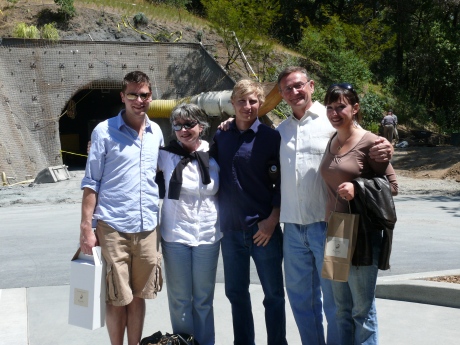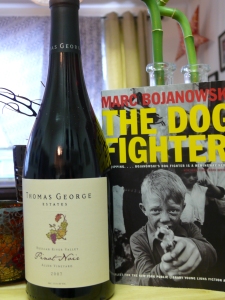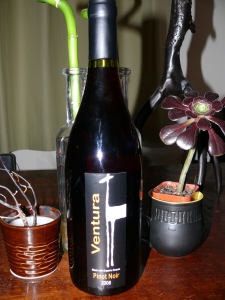Thomas George Estates’
Russian River Valley
Pinot Noir
Allen Vineyard
2007
Instead of striking the pallet, this milky-claret pinot brushes through the tongue. Its tartness is slightly abrasive and somehow not whole. Then, however, it turns. The flavors become darker, broader, richer, older, fuller and more complex—like aged velvet. This pinot lingers in the back of the throat for a long time, and you’re left with splinters of licorice and ink.
Marc Bojanowski, the author of The Dog Fighter and Cellar Master at Thomas George Estates, introduced me to this wine. When asked which one he would pair with his novel, he decided upon this Pinot.
Bojanowski has carefully crafted a story which embodies splintering mirrors. Set in 1940’s Mexico, The Dog Fighter chronicles the youth of the unnamed protagonist. As a child he starts to crack and splinter as he’s pulled in opposing directions by his brutish and fiery maternal grandfather and his civilized Spanish-born father. The boy lives for bedtime, when his grandfather tells brutal stories of his ancestors: fierce warriors who battle jaguars and kill with no remorse. Through these stories, his grandfather convinces the boy that to become whole and flawless, he must live his life as a warrior. Despite his father’s attempts to inspire a love for literature, language, and humanitarianism, the boy is guided by his grandfather’s nighttime whispers and hisses.
During the next four years, he travels through northern Mexico, to northern California and Texas, fighting, drinking, intimidating, and finding work where he can. In time he finds himself on a boat, gliding through the Sea of Cortez toward the hidden town of Cancion in the Baja Peninsula, where he is to start construction work on a tourist hotel.
The protagonist builds a reputation as a mute giant who is not to be trifled with. His size and strength catch the eyes of the business men, supervising the construction, and soon he is introduced to the world of dog fighting, led by the corrupt head-businessman Cantana. The dog fights, which take place under full moons, are underground events in which men fight trained dogs to the death. The protagonist’s first fight, in which he annihilates the dog, rockets him to fame, and he is now known as “Dog Fighter.” During this first fight, however, the Dog Fighter becomes irrevocably cracked: he sets eyes on an exceptionally beautiful woman, who has accompanied the merciless Cantana to the fights. Although, the brutality of the dog fights enables him to experience the flesh and blood of his grandfather’s hisses and whispers, all the Dog Fighter wants is this woman. He will only return to fight the dogs to see her.
After his first fight, he stops work on the hotel and meets an old, cantankerous poet who works in the marcado as a translator and a transcriber of letters. As the poet begins to teach the dogfighter how to speak English, he also awakens in him the literary influence of his father. But unlike his father who thought of Jesus as a daydreamer, the poet states, “God is a beautiful thing. The best poem we have.” The poet will not, however, enter the town’s church, stating: “This is a small game I play with God. I am always wanting him to walk out and he is always wanting me to walk in.”
As the Dog Fighter becomes more familiar with Cancion and its inhabitants, he realizes that war between the townies and the businessmen is brewing. The town’s people don’t want the hotel to block their sunsets and beaches; they don’t want their precious, hidden town to become overrun by tourists. Cantana, however, says he believes that the hotel will bring money, progress, and education to the children of Cancion.
Each opposing force desperately wants the Dog Fighter to fight as a soldier for their cause. The Dog Fighter is once again caught between opposing forces. His decision to remain centered in this conflict is driven by his consuming love.
The Dog Fighter is as intricate and striking as its partnered Pinot. The syntax (and lack of commas) is initially challenging, but as the story progresses, this style becomes vital to the voice’s authenticity. The narrator learned English from a poet whose native language is Spanish. More importantly, though, a poet’s job is to challenge syntax, so naturally a poet will teach the language in his own unique cadence.
Interestingly enough, Bojanowski’s character development follows the development of the Thomas George Estates’ Pinot. Characters who first appear abrasive and simple become richly complex and endearing (although not in a conventional way). And, Bojanowski’s splintered characters linger in the back of one’s throat for a long time.
The Dog Fighter contains rich and powerful metaphors, motifs, and parallels, but there is nothing structural or predictable in the way Bojanowski employed these literary tools. Instead of following the tired, old literary paradigm, Bojanowski masterfully composed his novel, and the characters within, “from thousands of tiny pieces of cracked tile and glass and mirror.”
Written with Tim Counihan and Palmi Möller

Marc (center) surrounded by my family and myself


